Natural Solutions to Things That Bug You (20 page)
Read Natural Solutions to Things That Bug You Online
Authors: Myles Bader

This spider frequently abandons its web to build a new one nearby and can produce numerous webs in a short period of time. This web-building behavior causes homeowners to do a lot of cleanup.
The common house spider female is about ¼ inches in length with a yellowish-brown upper body and a dirty white to brown abdomen with gray chevrons.
The legs of this spider are yellow, with darker rings at the end of each segment. Some members of this species have a triangular, black spot on the top of the abdomen. The male is a little smaller than the female in length and has orange legs. Males and females can be found anytime of the year and they can live for a year or more after maturing. The male and female will coexist in the web and mate repeatedly.
CRAB SPIDER
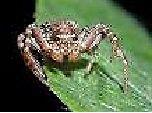 The crab spiders has a short, wide, flattened body with the first two or three pairs of legs longer than the rest and are normally held out from the sides of the body as a crab would hold its claws. Crab spiders can usually walk forward, backward, or sideways similar to fiddler crabs. There are about 2000 known species of crab spiders worldwide, 200 of which occur in North America.
The crab spiders has a short, wide, flattened body with the first two or three pairs of legs longer than the rest and are normally held out from the sides of the body as a crab would hold its claws. Crab spiders can usually walk forward, backward, or sideways similar to fiddler crabs. There are about 2000 known species of crab spiders worldwide, 200 of which occur in North America.
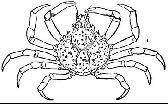
The majority of crab spiders are less than 1 cm (0.4 in) in length; however, the giant crab spider may reach 2.5 cm (1.0 in). They never spin webs to trap prey, but hunt on the open ground or on vegetation or flowers. They resemble free-living spiders such as jumping spiders and wolf spiders but unlike other free-living spiders all crab spiders eyes are small and serve primarily as motion detectors.
Crab spiders are predators that lie in wait to ambush their prey and even though their jaws are rather small and slender, many crab spiders have potent venoms that quickly immobilize their prey.
Many crab spiders are well camouflaged, blending in with their backgrounds and some even resemble tree bark, leaves, or fruits; others appear to mimic bird droppings.
GIANT HOUSE SPIDER
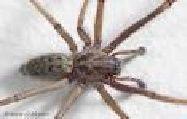 This spider is also known as the greater European house spider. With very long legs, the giant house spider is known to reach up to ¾ inches in size. The species are most commonly brown in color, with a pale mark at the middle of the breastplate. On each side of its breastplate it has four small circles arranged longitudinally.
This spider is also known as the greater European house spider. With very long legs, the giant house spider is known to reach up to ¾ inches in size. The species are most commonly brown in color, with a pale mark at the middle of the breastplate. On each side of its breastplate it has four small circles arranged longitudinally.
It is also believed to be the world's fastest spider. On a flat surface, giant house spiders are known to move at a speed of 1.73 feet per second. Giant house spiders are originally native to Europe but were introduced to North America through Vancouver Island in the 1920’s. Coastal areas and beaches are most susceptible to giant house spider infestations.
Giant house spiders usually live in flowerbeds, woodpiles and other sheltered, outdoor areas. However, inside, they can be found in dark crevices and basements.
JUMPING SPIDER
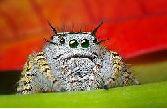 There are about 4,000 species for the jumping spider alone making it one of the largest of all other spider species, with more than 300 of those species found in the United States and about 75 found in Europe. The jumping spider averages almost 1-inch in length; the female spider is usually larger than the male. These spiders are also well known for their appearance and because of it they are easily spotted. They are typically brightly colored, have very outstanding patterns, and are also hairy and sometimes stocky.
There are about 4,000 species for the jumping spider alone making it one of the largest of all other spider species, with more than 300 of those species found in the United States and about 75 found in Europe. The jumping spider averages almost 1-inch in length; the female spider is usually larger than the male. These spiders are also well known for their appearance and because of it they are easily spotted. They are typically brightly colored, have very outstanding patterns, and are also hairy and sometimes stocky.
Jumping spiders have four pair of eyes, two of which give it extremely sharp vision; so sharp that it actually allows it to see better than almost any animal of the same size. The jumping spider’s eyes allow it to have a 360-degree eyesight and also has the ability to turn its breast around 45 degrees. The jumping spider is typically found in tropic regions, from the rain forest to the Himalayas. The spider can be found on the ground, on rocks, in the grass, or on trees.
Because their great eyesight, their prey can be noticed anywhere from 12 to 18 inches away. At this point, the jumping spider scans their prey with eyesight similar to that of a zoom lens on a camera. When the prey is regarded as eatable, the jumping spider will move closer and attack with a line of silk and jump or pounce on it.
The jumping spider is not poisonous to humans and like a wolf spider, the jumping spider typically does not attack humans unless they feel threatened or in danger.
LYNX SPIDER
 They are more common in the southern United States. They use their green camouflage to sneak up on their victims in the daylight. The lynx spider can be found on grass and low herbage. It is a long legged hunting spider capable of running fast and jumping on their prey. They do not make a web but hunt their prey but do not have the greatest eyesight.
They are more common in the southern United States. They use their green camouflage to sneak up on their victims in the daylight. The lynx spider can be found on grass and low herbage. It is a long legged hunting spider capable of running fast and jumping on their prey. They do not make a web but hunt their prey but do not have the greatest eyesight.
They can only see prey for a distance of about 4-inches. Lynx spiders have two large front eyes and a smaller pair, two on the side of their head and two large ones looking above and backward giving them an almost 360 degree view. They can be found in a variety of colors. These spiders are active during the day, preferable in the sunshine, running and jumping over leaves and grasses.
PSEUDOSCORPIONS
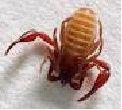 In North America there are over 200 species of pseudoscorpions and although very common, they are only occasionally found indoors and then only a few at any given time. Pseudoscorpions can be found in any room in a house; however, they are usually more common in damp areas, such as laundry rooms, basements and bathrooms. They look scary in appearance, but are harmless to people.
In North America there are over 200 species of pseudoscorpions and although very common, they are only occasionally found indoors and then only a few at any given time. Pseudoscorpions can be found in any room in a house; however, they are usually more common in damp areas, such as laundry rooms, basements and bathrooms. They look scary in appearance, but are harmless to people.
Pseudoscorpion, means “fake scorpions.” They are small (most are about 1/5 inch long) and reddish or brown. They have oval, flat body with two pincer-like appendages. When they walk, they often look crab-like and are able to move as quickly backward as they move forward. They are actually a type of arachnid and are related to spiders, ticks and scorpions. In fact, without their pincers, they look very much like ticks.
Pseudoscorpions are also similar to scorpions but do not have the long tail and stinger that is common to scorpions. They live in many different types of habitats, including forests, grasslands; sand dunes and even around beaches. They prefer to live in crevices and similar spaces and can be found in leaf litter, moss and even under tree bark and stones as well as in bird and mammal nests.
Many pseudoscorpions favor sites that have with high humidity, although some species can tolerate a degree of dry conditions. Even though they are not commonly seen, pseudoscorpions can be quite abundant. If the conditions are favorable, hundreds can be found within just one square yard.
These “false scorpions” will feed on many types of small insects and other arthropods, including springtails, bark and book lice, beetles, flies, ants, and mites. They may even stalk their prey while others prefer to ambush insects. They have poor vision, usually possessing two eyes, four eyes and some have no eyes. They use sensory hairs to sense when prey is nearby and when a small insect brushes against these sensory hairs, it triggers a reaction and they seize the insect.
The majority of pseudoscorpions have poison glands in their pincer-like claws which they use to paralyze prey, while they inject saliva into the victim then feeds on the liquid contents. Pseudoscorpions produce silk from glands on their mouthparts and use the silk to spin cocoons in which they overwinter and deposit molted exoskeletons. They also use silk to make sacs that protect their eggs.
When they mate, they usually first engage in a complex courtship dance and after the female is fertilized, she carries her eggs in a sac attached to her abdomen. Once the young is hatched, they remain on their mother obtaining nourishment for a short time before moving away on their own.
RED HOUSE SPIDER
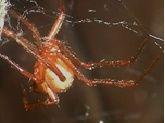 The red house spider is a tropical arachnid, also known as the red-legged house spider and is often mistaken for the dangerous redback spider. However, the bite of the red house spider is not dangerous and symptoms typically are no more severe than localized pain.
The red house spider is a tropical arachnid, also known as the red-legged house spider and is often mistaken for the dangerous redback spider. However, the bite of the red house spider is not dangerous and symptoms typically are no more severe than localized pain.
